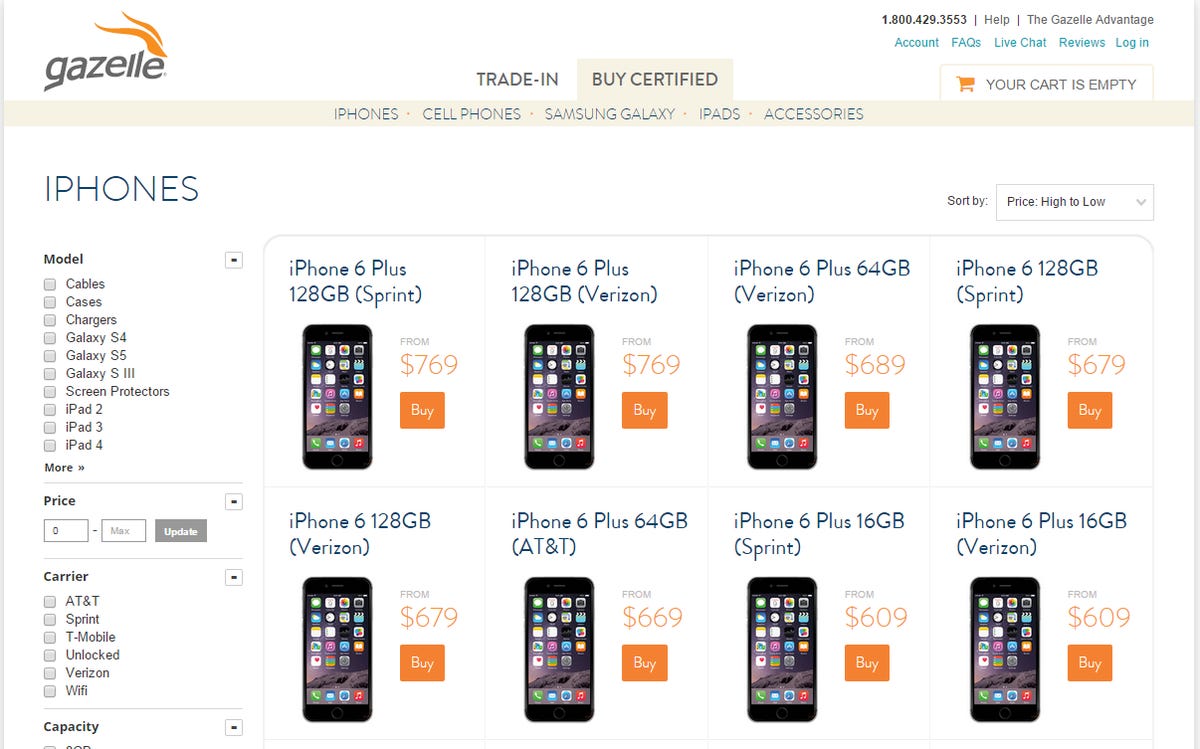Your beautiful iPhone 6S is beyond repair, and you’re stuck with two options: Purchase a brand-new, contract-free iPhone 6S for $650+, or try your luck buying used.
There are three main ways to buy a used iPhone — assuming you don’t have a friend or family member who wants to sell you one on the cheap. You can purchase a certified preowned iPhone from a reputable seller, such as Gazelle; you can bid on a preowned iPhone on an auction site such as eBay; or you can pay cash for a used iPhone from a local seller on a site like Craigslist (or at a pawn shop, I suppose).


Screenshot by Sarah Jacobsson Purewal/CNET
The method you choose depends on how much risk you’re willing to take for a discount — while Gazelle’s iPhones are inspected and guaranteed to be in working order, they’re still pretty pricey (especially considering the iPhone 6S is almost a year old). A 16GB Verizon-locked gold iPhone 6S in “excellent” condition will set you back $499 on Gazelle, whereas you can pick up the same model — but in brand-new condition — for just $50 more on Ebay.
No matter which method you choose, follow these four tips to make sure your used iPhone is as awesome and problem-free as a new iPhone.
Related stoires
- Tips for buying and selling used iPhones
- Switching carriers? You may be able to take your iPhone 5S with you
Buy the right phone for your carrier
It used to be simple — there were two types of iPhones, GSM and CDMA. The GSM phones worked solely on GSM networks (AT&T and T-Mobile), while the CDMA phones were regulated to CDMA networks (Verizon and Sprint). Starting with the iPhone 5 and LTE, however, it got a bit more complicated.
The iPhone 6s comes in two models (well, technically three, but one is only sold in China): A1633 and A1688. The iPhone 6s Plus also comes in two (technically three) models: A1634 and A1687. All of these models will work on all of the major carriers (AT&T, Sprint, T-Mobile and Verizon). However, the iPhone 6s A1633 and the iPhone 6s Plus A1634 both support one extra LTE band: The 2.3GHz spectrum, also known as the Wireless Communications Service (WCS) band, which is licensed by AT&T (and other non-wireless companies).
(You can check out our full explanation of wireless spectrum here.)
This extra LTE band has fewer users than the other bands, and so it can mean faster speeds in more densely-populated areas. In other words, it’s still smart to buy the iPhone 6S or 6S Plus model made for your wireless provider. AT&T users should look for the iPhone 6S A1633 or the iPhone 6S Plus A1634, while T-Mobile, Sprint and Verizon users should look for the iPhone 6S A1688 or the iPhone 6S Plus A1687.
If you’re on a smaller network, such as Boost, Cricket or Straight Talk, you can check out Apple’s LTE page to see which iPhone model is the best for your network.
Make sure it’s not stolen
Before you send a payment to an Ebay seller, or exchange cash in person with a Craigslist character, use Apple’s Activation Lock status tool to check and make sure the iPhone you’re eyeing hasn’t been stolen. You’ll need the device’s IMEI or serial number to check the status, but this shouldn’t be an issue — if the seller is legitimate, he or she will have no problems handing over this information.
Make sure it can be activated on your network
Theft isn’t the only way a phone can become blocked from a network. Even if the Activation Lock is turned off and you’ve followed my first recommendation, it’s still a good idea to give your carrier a call and check to make sure everything is aboveboard.
To do this, ask the seller for the IMEI number (AT&T and T-Mobile) or the MEID number (Verizon and Sprint) and then give your carrier a call to make sure the phone can be activated under your own account. You can check an IMEI number online on AT&T’s website or on T-Mobile’s website, and you can check an ESN, IMEI or MEID number on Verizon’s website.
Check the phone for damage
The obvious way to check for damage is to look at the phone. Scratches and dents to the casing are fine, but the phone shouldn’t look like it’s been through a UFC match. Minor cracks to the edge of the screen shouldn’t be a problem, but hairline cracks that lead across the screen can lead to more damage as the phone gets used. Check the buttons for usability (including the Home button’s fingerprint reader, if applicable), plug some headphones into the headphone jack, play music over the speakers, and check the screen for dead pixels using the iPhone Dead Pixel Test.
You should also check the water damage indicators — in the iPhone 6S and 6S Plus, the indicator is located inside the SIM card slot — to make sure the phone hasn’t been tossed in a pool recently.



